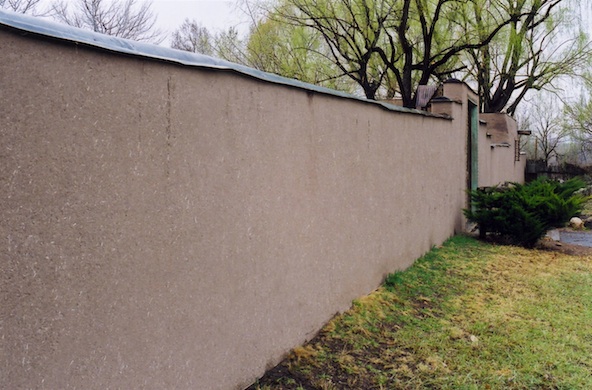Straw in Mud Plaster: Don't Ask Why, Just Do It!
Ed Crocker
The maintenance of mud-plastered walls has proven the single most difficult and time-consuming procedure endemic to earthen buildings that are not protected by an overhanging roof. Now that the fallacy of the "permanent" solution of Portland cement has been exposed as several decades' accumulation of moisture has threatened most and destroyed some of the buildings that it was intended to protect, and with a renewed interest in historic and cultural preservation, some of the old techniques of building and maintaining adobe are coming back into their own. Always of interest to both the owners of buildings and professional preservationists are the methods of mixing and applying mud plasters so that they endure.
It is an oft-heard phrase among the old adoberos of New Mexico that "un adobe sin paja is un adobe sin alma" (an adobe without straw is an adobe without soul). In a verbal, axiomatic tradition, this was a method of saying "Use straw!" without explaining why. It is understood that straw performs certain functions, including balancing the granulometry in adobes and mortars. It has other functions in the exterior mud renderings of buildings as well that may not always be understood, though they are still practiced.

The greatest threat to an unprotected adobe wall in the Southwestern United States is erosion by water. Summertime convection storms may unleash violent torrents that, though of short duration, are intense mechanisms of destruction. Water flowing down a vertical surface, unless it is deflected from a straight path, will rapidly cut a channel out of mud plaster and expose the adobe fabric beneath. One method of countering the force of high-velocity water erosion is to break the velocity of the downward flow. This may be done by re-directing the rivulets so that instead of flowing straight, they are forced to follow a random, labyrinthine path to the wall base. Straw, properly mixed and applied in a mud render is an effective device to retard erosion.
While watching the women of Taos Pueblo re-mud a wall, I noticed that the mud was thrown onto the surface and then, using the heel of the hand, worked upwards in a low, arching motion away from the body. The print was that of half a rainbow. The straw in the mix was no more that 2 inches long and most of the pieces, as a result of the hand motion, were embedded either horizontally or only a few degrees off the horizontal. When I looked at a wall that had not been re-mudded for several seasons I could see the efficacy of the technology.
A rivulet beginning at parapet height encounters a barrier across its path and is diverted to one side. A few inches below, it is again diverted, and in some cases divided by the straw. The downward velocity is broken and erosion reduced. In essence, the straw causes the water to sheet on the wall rather than to channel. This distribution of moisture also allows for more rapid evaporation when the rain stops.
The same result can be achieved by using a hawk and trowel to apply the mud rendering. By "cutting" the mud on the hawk away from the body using the edge of the trowel, the straw fibers are aligned perpendicular to the plane of the trowel. By cutting and lifting the mud onto the trowel and applying it in horizontal paths, the straw is embedded generally parallel to the ground. A final, horizontal pass with the trowel aligns the surface straw. Again, the length of the straw is critical to the success of the render: Long fiber won't align. 1-1/2 to 2 inches is optimum length.
The recipe, or mix for the mud is another critical element, but that discussion will have to wait for another day.

